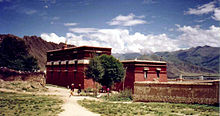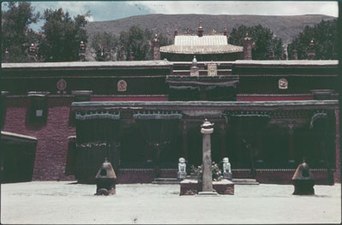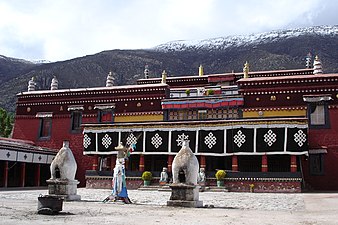| Nechung Monastery | |
|---|---|
| Tibetan transcription(s) Tibetan: གནས་ཆུང་ལྕོག Wylie transliteration: gnas-chung lcog Official transcription (China): Naiqung Gönba Chinese transcription(s) Traditional: 乃琼寺 | |
 | |
| Religion | |
| Affiliation | Tibetan Buddhism |
| Sect | Nyingma |
| Location | |
| Location | Doilungdêqên District, Lhasa, Tibet Autonomous Region, China |
| Country | China |
 | |
| Geographic coordinates | 29°40′17″N 91°3′21″E / 29.67139°N 91.05583°E / 29.67139; 91.05583 |
| Part of a series on |
| Tibetan Buddhism |
|---|
 |
| Schools |
Key personalities
|
Teachings
|
| Practices and attainment |
| Major monasteries |
| Institutional roles |
| Festivals |
| Texts |
| Art |
| History and overview |
Nechung Monastery, Nechung Gompa (Tibetan: གནས་ཆུང་དགོན་པ།, Wylie: gnas-chung lcog, ZYPY: Naiqung Gönba) or Nechung Chok (Tibetan: གནས་ཆུང་ལྕོག, ZYPY: Naiqung Jog "the small dwelling", Chinese: 乃琼寺), is the seat of the State Oracle of Tibet. It is also referred to as Sungi Gyelpoi Tsenkar, the "Demon Fortress of the Oracle King."
It is about 10 minutes walk down from Drepung Monastery, and was the residence of the three-headed, six-armed Pehar Gyalpo, the chief protector of the Gelugs (Yellow Hat sect) and the seat of the State Oracle or Nechung Oracle. It is a medium-sized temple which used to house about a hundred monks.
History and functions
It was the seat of State Oracle until 1959 when he fled with the Dalai Lama to India who now lives in exile in Dharamsala, India. The Dalai Lamas traditionally always consulted him before making an important decision.
It was the residence of the Protector Pehar, a deity of the Horpa, who lived to the east of (Lake) Kokonor. According to tradition, he is held to have been originally brought to Samye Monastery by Padmasambhava who bound him to protect the dharma. An alternative story is that he was brought back by a Bon general, Tara Lugong, who took possession of the meditation school near Kanchow of the Bhaţa Hor, a tribe of Uighurs, about the end of the 8th century CE. Pehar was regarded as the guardian deity of the treasures of Samye Monastery and, later, as the 'protector of religion'.
-
 The main temple of Nechung monastery, with pillar or doring (rdo ring), 2 incense burners and 2 stone lions behind, before 1950
The main temple of Nechung monastery, with pillar or doring (rdo ring), 2 incense burners and 2 stone lions behind, before 1950
-
 Main temple in 2006
Main temple in 2006
-
 Main temple in 2010
Main temple in 2010
-
 Nechung, 2013
Nechung, 2013
-
 Nechung in art from 1850s
Nechung in art from 1850s
During the time of Lobsang Gyatso, the Fifth Dalai Lama (r. 1642–1682), Pehar was first moved from Samye to Tse Gugtang and then to the present site of Nechung Monastery.
Although the State Oracle is a Nyingma monk, he has been adopted by the Gelugpas and is now chosen for his receptivity to possession by Pehar during trance. He is considered to be the medium of Dorje Drakden, one of Pehar's aspects.
According to belief, when the State Oracle is possessed by Pehar, he becomes very agitated, with tongue lolling, bloodshot eyes and displays superhuman strength, lifting heavy weights, twisting swords, etc. He mumbles words which are recorded and then interpreted by monks and also blesses grain which is thrown to the crowd.
Unlike most Central Asian shamans, who are thought to leave their bodies when in a trance-like state and travel to the land of the spirits from where they bring back messages, Tibetan oracles act "as a mouthpiece for the gods or spirits who possess him and speak through him, very often without his own knowledge of what is being said, answering directly the questions of those who consult him." The tradition of oracles was inherited from the pre-Buddhist religion of Tibet, Bön. The "great" Fifth Dalai Lama was "the first to institutionalise the State Oracle of Nächung."
Nechung was almost completely destroyed during the Cultural Revolution and annexation of Tibet by China, though now, it has been largely restored and there is a huge new statue of Guru Rinpoche (Padmasambhava) on the second floor. There is a college of debate to the east of Nechung which is once again attended by young students.
A new Nechung Monastery has been built in Dharamsala, India.
-
Retreat of the 13th Dalai Lama, Nechung, Tibet
-
Throne awaiting Dalai Lama's return. Retreat of the 13th Dalai Lama, Nechung, Tibet.
-
 Nechung in Dharamsala, India
Nechung in Dharamsala, India
-
Prayer wheels at Nechung Chok, Lhasa
Footnotes
- Dowman (1988), pp. 66–67.
- ^ Mayhew & Kohn (2005), p. 22.
- Chapman (1940), p. 201.
- Peter (1979), pp. 51–56.
- ^ Dowman (1988), p. 67.
- Stein (1972), pp. 68, 189.
- Stein (1972), pp. 187–188.
- Chapman (1940), p. 317.
- Peter (1979), p. 52.
- Osada, Allwright & Kanamaru (2004), p. 83.
References
- Chapman, F. Spencer (1940). Lhasa: The Holy City. London: Readers Union Ltd.
- Dowman, Keith (1988). The Power-places of Central Tibet: The Pilgrim's Guide. London: Routledge & Kegan Paul. ISBN 0-7102-1370-0.
- Mayhew, Bradley; Kohn, Michael (2005). Tibet. Lonely Planet Publications. ISBN 1-74059-523-8.
- Peter, Prince of Greece and Denmark (Summer 1979). "Tibetan Oracles". The Tibet Journal. 4 (2): 51–56.
{{cite journal}}: CS1 maint: date and year (link) - Osada, Yukiyasu; Allwright, Gavin; Kanamaru, Atsushi (2004) . Mapping the Tibetan World (Reprint ed.). Tokyo: Kotan Publishing. ISBN 0-9701716-0-9.
- Stein, R. A. (1972). Tibetan Civilization. Stanford University Press.
Further reading
- Bell, Christopher Paul (2013). Nechung: The Ritual History and Institutionalization of a Tibetan Buddhist Protector Deity (dissertation). Retrieved 12 July 2021 – via Academia.edu.
External links
- Nechung the State Oracle of Tibet by David Cherniack
- CD Recording of the Nechung Monks Traditional Chants of Tibet
 Nechung travel guide from Wikivoyage
Nechung travel guide from Wikivoyage Media related to Nechung at Wikimedia Commons
Media related to Nechung at Wikimedia Commons
| Buddhist monasteries in Tibet | |
|---|---|
| Lhasa |
|
| Lhoka Prefecture | |
| Shigatse |
|
| Ngari Prefecture | |
| Chamdo Prefecture and former Kham | |
| Nyingchi Prefecture | |
- Nyingma monasteries and temples
- Buddhist monasteries in Lhasa (prefecture-level city)
- Buddhist temples in Tibet
- 17th-century establishments in Asia
- Doilungdêqên District
- Buildings and structures in Dharamshala
- Tibetan Buddhist monasteries and temples in India
- Temples in Himachal Pradesh
- Buddhist monasteries in Himachal Pradesh

